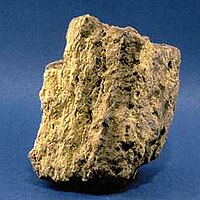
Photo from wikipedia
Carbonaceous debris (CD) is widely distributed in the sandstone of the Daying Uranium Deposit, northern Ordos Basin, and coexists with uranium minerals, which provides a favorable case for studying their… Click to show full abstract
Carbonaceous debris (CD) is widely distributed in the sandstone of the Daying Uranium Deposit, northern Ordos Basin, and coexists with uranium minerals, which provides a favorable case for studying their relationship. Vitrinite reflectance (VR), macerals, moisture, volatile matter, ash, total sulfur (St) and uranium concentration of CD within the sandstone were studied. The results show that VR ranges from 0.372 %Ro to 0.510 %Ro with an average value of 0.438 %Ro, indicating that CD is in the stage of lignite. The contents of vitrinite (V), inertinite (I) and minerals range from 83.18%–99.48%, 0–7.70%, and 0.34%–15.72%, respectively, with the corresponding average value of 95.51%, 1.34%, and 3.15%, respectively which indicates that V is the major maceral. Moisture on air dried basis (Mad), volatile matter yield on dry, ash-free basis (Vdaf), ash yield on dried basis (Ad) and St mostly range from 7.95%–16.09%, 44.70%–66.54%, 4.84%–26.24% and 0.24%–1.12%, respectively, while their average values are 12.43%, 53.41%, 16.57% and 0.77%, respectively. It suggests that CD is of medium-high moisture, super-high volatile matter, low-medium ash and low sulfur. Uranium concentration ranges from 29 ppm to 92 ppm with an average value of 50 ppm, and uranium concentration increases with the decreased distance to CD. On the whole, Mad and Vdaf decrease with increasing burial depth, which indicates that CD experienced the burial metamorphism. However, Mad and Vdaf obviously decrease in uranium-rich areas whereas Ad and St noticeably increase. Comprehensive studies suggest that there is a certain relationship between uranium enrichment and CD. CD in the stage of lignite helps the adsorption of uranium. On one hand, radioactivity uranium enrichment makes organic matter maturation increase with a decrease in moisture and volatile matter. On the other hand, an increase in organic matter maturation, caused by radioactivity uranium enrichment, results in an increase in uranium minerals, which is instructive in the study of regional uranium mineralization and metallogenic regularity.
Journal Title: Journal of Earth Science
Year Published: 2019
Link to full text (if available)
Share on Social Media: Sign Up to like & get
recommendations!